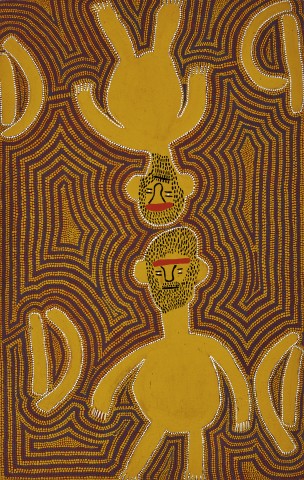PUNGKALUNGKA MAN, 1985
MICK NAMARARI TJAPALTJARRI
synthetic polymer paint on linen
162.0 x 103.0 cm
Purchased by the artist Tim Johnson directly from the Papunya Tula Artists storeroom in 1983
Tim and Vivien Johnson collection
Private collection, Sydney
According to Mr Johnson, Namarari explained that the painting depicted the Pungkalungka Man. The then Papunya Tula Artist’s manager, Daphne Williams, sold the work without a catalogue number or documentation as she found the subject matter unusual and had placed the work temporarily into the storage (personal correspondence with Tim Johnson).
Two Worlds Collide, Artspace, Sydney, 1985 (illus., as ‘Pulku Pulku Men’ on front cover of exhibition catalogue)
Western Desert painting operates in the space between ceremony and country, referencing each whilst exploring ancestral inheritance. Mick Namarari's works are loaded with symbolism which is closely tied to traditional narratives in a densely and tightly coded abstraction. He developed a visual language which was influenced by cultural protocol, but never restrained by it. His innovation was a consequence of his continual need to paint and a refining of his imagery over time. Namarari was one of the first to experiment with fields of dotting devoid of figuration or traditional design motifs and in the early 1990s, together with Turkey Tolsen Tjupurrula, Namarari explored minimal representation. Utilising bold, undotted lines of colour and at the same time focusing on just one aspect of a story, this shift in direction would influence Papunya Tula painting from the late 1990s well into the 2000s.
This work painted 1983, is a rendition of the Punkalungku, mythical men who lived in a large cave in the hills near Papunya and who frightens and punishes lawbreakers. Painted on a black ground, the repeated figure of the giant framed by alternating broad bands of red and yellow ochre creates a minimal repetitious template typical of the artist’s work at this time.
One of the most accomplished artists of the founding Papunya painters, Namarari also served on the Papunya Council. In 1991 he was awarded the National Aboriginal Art Award, a moment which heralded not only public attention for the Papunya Tula artists, but also confirmed the importance of his practice within the community. Exhibited in every Australian capital and at international art fairs, Namarari spearheaded the acceptance of Western Desert art in the ultra-competitive world of contemporary art.
